SpringMVC

一、SpringMVC
1.1 引言
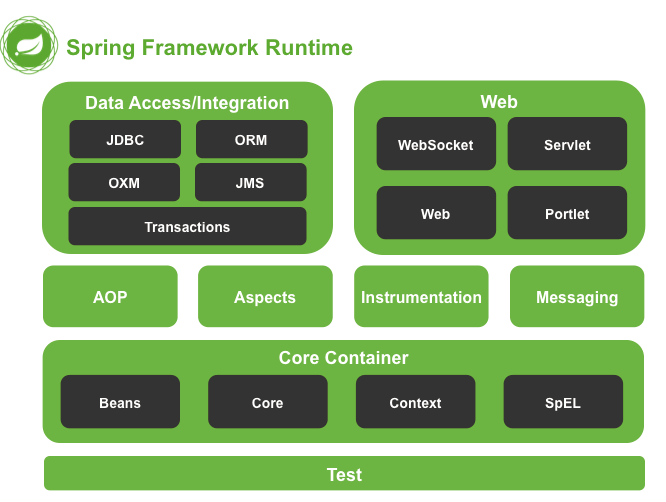
提示
java开源框架,Spring Framework的一个独立模块。
MVC框架,在项目中开辟MVC层次架构
对控制器中的功能 包装 简化 扩展践行工厂模式,功能架构在工厂之上
1.2 MVC架构
1.2.1 概念
| 名称 | 职责 |
|---|---|
| Model | 模型:即业务模型,负责完成业务中的数据通信处理,对应项目中的 service和dao 指工程中的javabean,用来处理数据。这个javabean分两类:1.实体类的bean 专门封装数据2.业务处理bean,比如 service 和 dao ,用于处理业务逻辑和数据访问 |
| View | 视图:渲染数据,生成页面。对应项目中的Jsp , html 等 作用是与用户交互 展示数据 |
| Controller | 控制器:直接对接请求,控制MVC流程,调度模型,选择视图。对应项目中的Servlet 接受请求 和 响应数据给浏览器 |
MVC的工作流程: 用户通过视图层 发送请求到 服务器 ,在服务器中 请求被 Controller 接受,Controller 则调用响应的model层来处理请求,处理完之后的结果 返回给Controller,然后 controller 把结果响应给View 视图,渲染数据 最终展示在浏览器
1.2.2 好处
MVC是现下软件开发中的最流行的代码结构形态;
人们根据负责的不同逻辑,将项目中的代码分成 M V C 3个层次;
层次内部职责单一,层次之间耦合度低;
符合低耦合 高内聚的设计理念。也实际有利于项目的长期维护。
二、开发流程
2.0 创建web项目
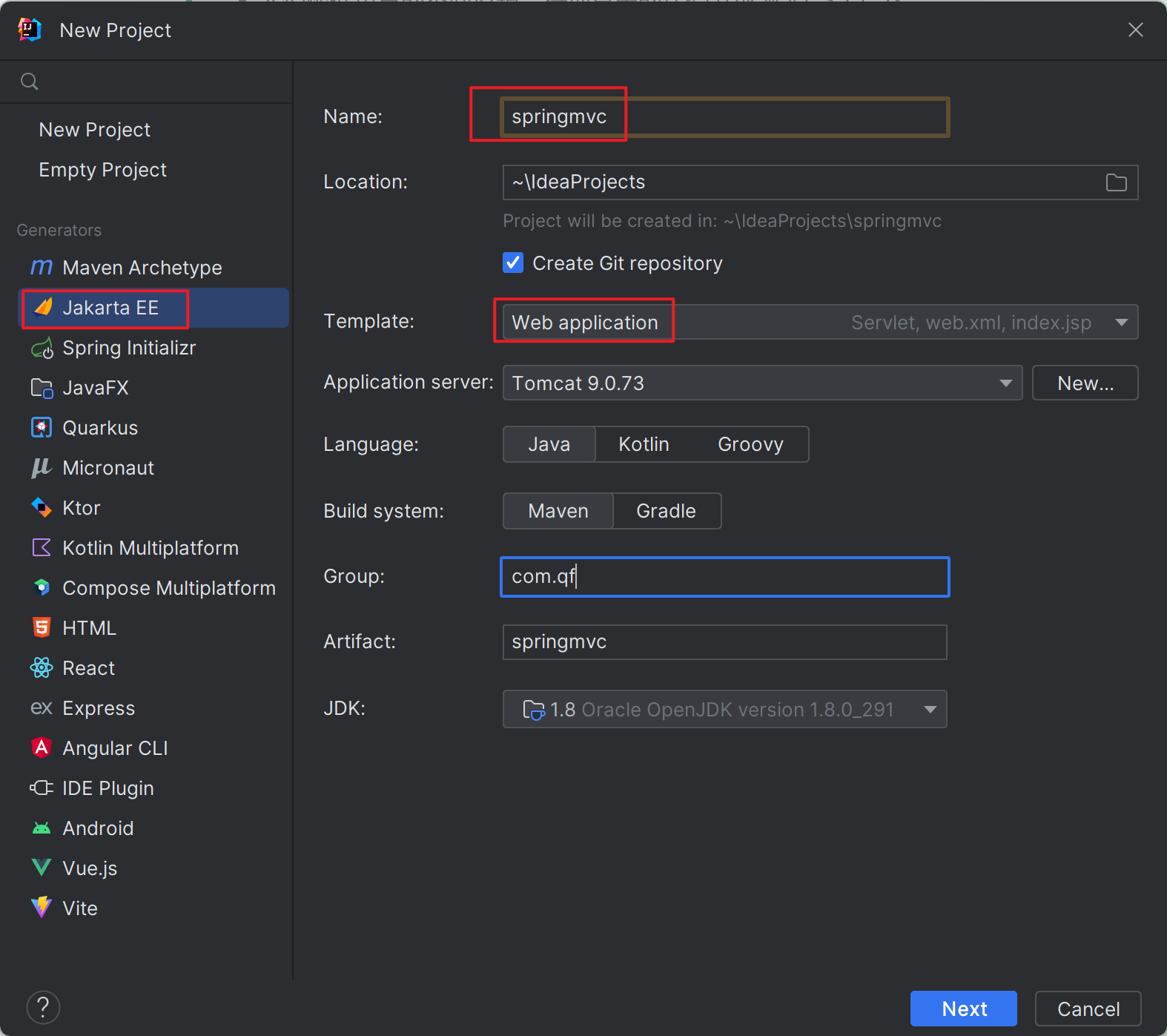
选择模块
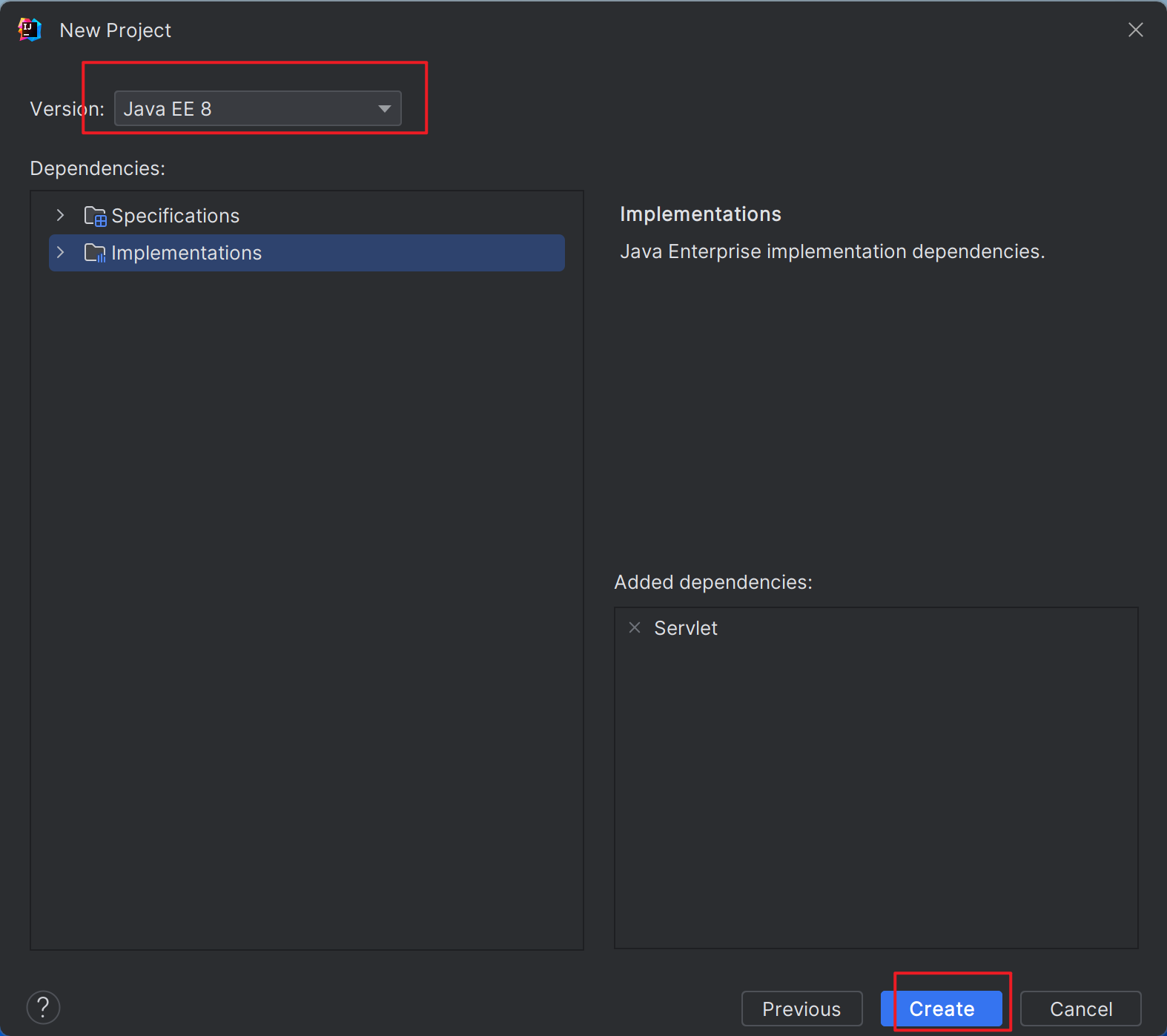
删除不需要的文件
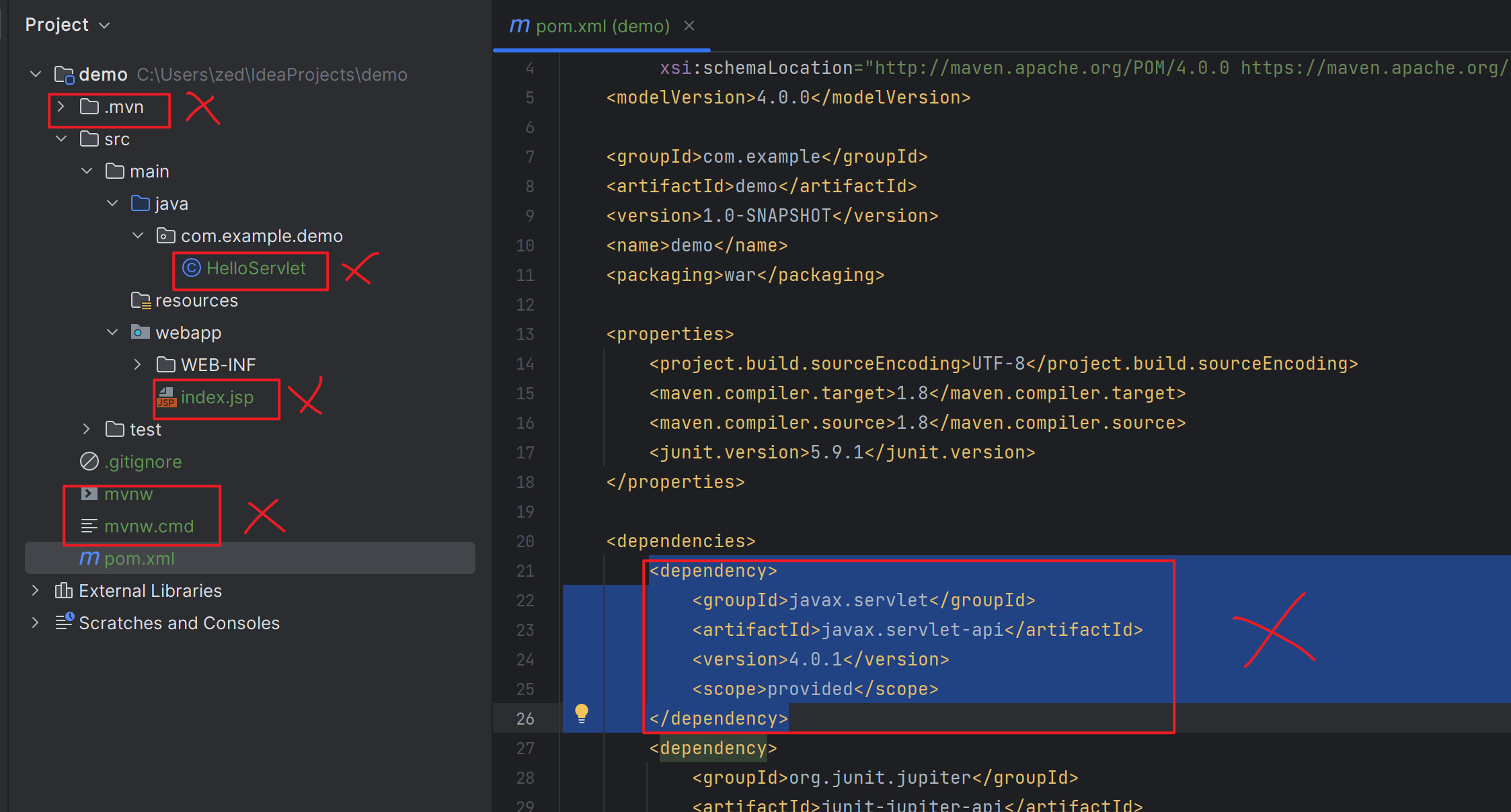
2.1 导入依赖
<dependency>
<groupId>org.springframework</groupId>
<artifactId>spring-webmvc</artifactId>
<version>5.1.6.RELEASE</version>
</dependency>
2.2 配置核心(前端)控制器
作为一个MVC框架,首先要解决的是:如何能够收到请求!
所以MVC框架大都会设计一款前端控制器,选型在 Servlet 或 Filter两者之一,在框架最前沿率先工作,接收所有请求。
此控制器在接收到请求后,还会负责springMVC的核心的调度管理,所以既是前端又是核心。
补充:DispatcherServlet 前端控制器 ,是框架提供的,作用 统一处理请求和响应,整个流程的控制中心,是由它来调用其他组件处理用户的请求
<servlet>
<servlet-name>mvc</servlet-name>
<servlet-class>org.springframework.web.servlet.DispatcherServlet</servlet-class>
<!-- 局部参数:声明配置文件位置 -->
<init-param>
<param-name>contextConfigLocation</param-name>
<param-value>classpath:mvc.xml</param-value>
</init-param>
<!-- Servlet启动时刻:可选 -->
<load-on-startup>1</load-on-startup>
</servlet>
<servlet-mapping>
<servlet-name>mvc</servlet-name>
<url-pattern>/</url-pattern>
</servlet-mapping>
2.3 后端控制器
等价于之前定义的Servlet
@Controller //声明这是一个控制器
@RequestMapping("/hello") //访问路径 ,等价于url-pattern
public class HelloController {
@RequestMapping("/test1") //访问路径
public String hello1(){
System.out.println("hello world");
return "index"; // 跳转:/index.jsp
}
}
2.4 配置文件
默认名称:核心控制器名-servet.xml 默认位置:WEB-INF
随意名称:mvc.xml 随意位置:resources 但需要配置在核心控制器中
<beans xmlns="http://www.springframework.org/schema/beans"
xmlns:context="http://www.springframework.org/schema/context"
xmlns:mvc="http://www.springframework.org/schema/mvc"
xmlns:xsi="http://www.w3.org/2001/XMLSchema-instance"
xsi:schemaLocation="http://www.springframework.org/schema/beans
http://www.springframework.org/schema/beans/spring-beans.xsd
http://www.springframework.org/schema/context
http://www.springframework.org/schema/context/spring-context.xsd
http://www.springframework.org/schema/mvc
http://www.springframework.org/schema/mvc/spring-mvc.xsd">
<!-- 告知springmvc 哪些包中 存在 被注解的类 -->
<context:component-scan base-package="com.qf.controller"></context:component-scan>
<!-- 注册注解开发驱动 -->
<mvc:annotation-driven></mvc:annotation-driven>
<!-- 视图解析器
作用:1.捕获后端控制器的返回值="index"
2.解析: 在返回值的前后 拼接 ==> "/index.jsp"
-->
<bean class="org.springframework.web.servlet.view.InternalResourceViewResolver">
<!-- 前缀 -->
<property name="prefix" value="/"></property>
<!-- 后缀 -->
<property name="suffix" value=".jsp"></property>
</bean>
</beans>
2.5 访问
http://localhost:8080/hello/test1
三、接收请求参数
3.1 基本类型参数
请求参数和方法的形参 同名即可
springMVC默认可以识别的日期字符串格式为: YYYY/MM/dd HH:mm:ss
通过@DateTimeFormat可以修改默认日志格式
// id name gender
// http://localhost:8989/xxx/../test1?id=1&name=zzz&gender=false&birth=2018-12-12 12:20:30
@RequestMapping("/test1")
public String testParam1(@RequestParam("id")Integer id,
String name,
Boolean gender,
@DateTimeFormat(pattern="yyyy-MM-dd HH:mm:ss")Date birth){
System.out.println("test param1");
return "index";
}
3.2 实体收参【重点】
请求参数和实体的属性 同名即可
public class User {
private Integer id;
private String name;
@DateTimeFormat(pattern="yyyy-MM-dd")
private Date birth;
private Boolean gender;
//set/get ...
}
//http://localhost:8989/.../test2?id=1&name=zzz&gender=false&birth=2018-12-12 12:20:30
@RequestMapping("/test2")
public String testParam2(User user){
System.out.println("test param2");
System.out.println("user:"+user);
return "index";
}
3.3 数组收参
简单类型的 数组
<form>
......
<input type="checkbox" name="hobby" value="fb"/>足球
<input type="checkbox" name="hobby" value="bb"/>篮球
<input type="checkbox" name="hobby" value="vb"/>排球
</form>
//http://localhost:8989/.../test3?hobby=football&hobby=basketball
@RequestMapping("/test3")
public String testParam3(String[] hobby){
for(String h:hobby){
System.out.print(h+" ");
}
return "index";
}
3.4 集合收参 【了解】
// GET http://localhost:8080/hello/welcome?idList=1,2,3,4
@RequestMapping("/welcome")
public String welcome(@RequestParam List<Integer> idList){
System.out.println(idList);
return "welcome";
}
3.5 路径参数
// {id} 定义名为id的路径
// http://localhost:8989/.../hello/10 {id}匹配到10
@RequestMapping("/hello/{id}")
// @PathVariable将{id}路径匹配到值赋给id参数
// 路径名和参数名相同则@PathVariable("id")可简写为 @PathVariable
public String testParam5(@PathVariable("id") Integer id){
System.out.println("id:"+id);
return "index";
}
// http://localhost:8989/.../hello/tom {username}匹配到tom
@RequestMapping("/hello/{username}")
public String testParam6(@PathVariable("username") String name){//将{username}路径匹配到的值赋给name参数
System.out.println("username:"+name);
return "index";
}
3.6 中文乱码
首先,页面中字符集统一
JSP : <%@page pageEncoding="utf-8" %>
HTML : <meta charset="UTF-8">
如果是IDEA开发,在IDEA中指定Tomcat编码
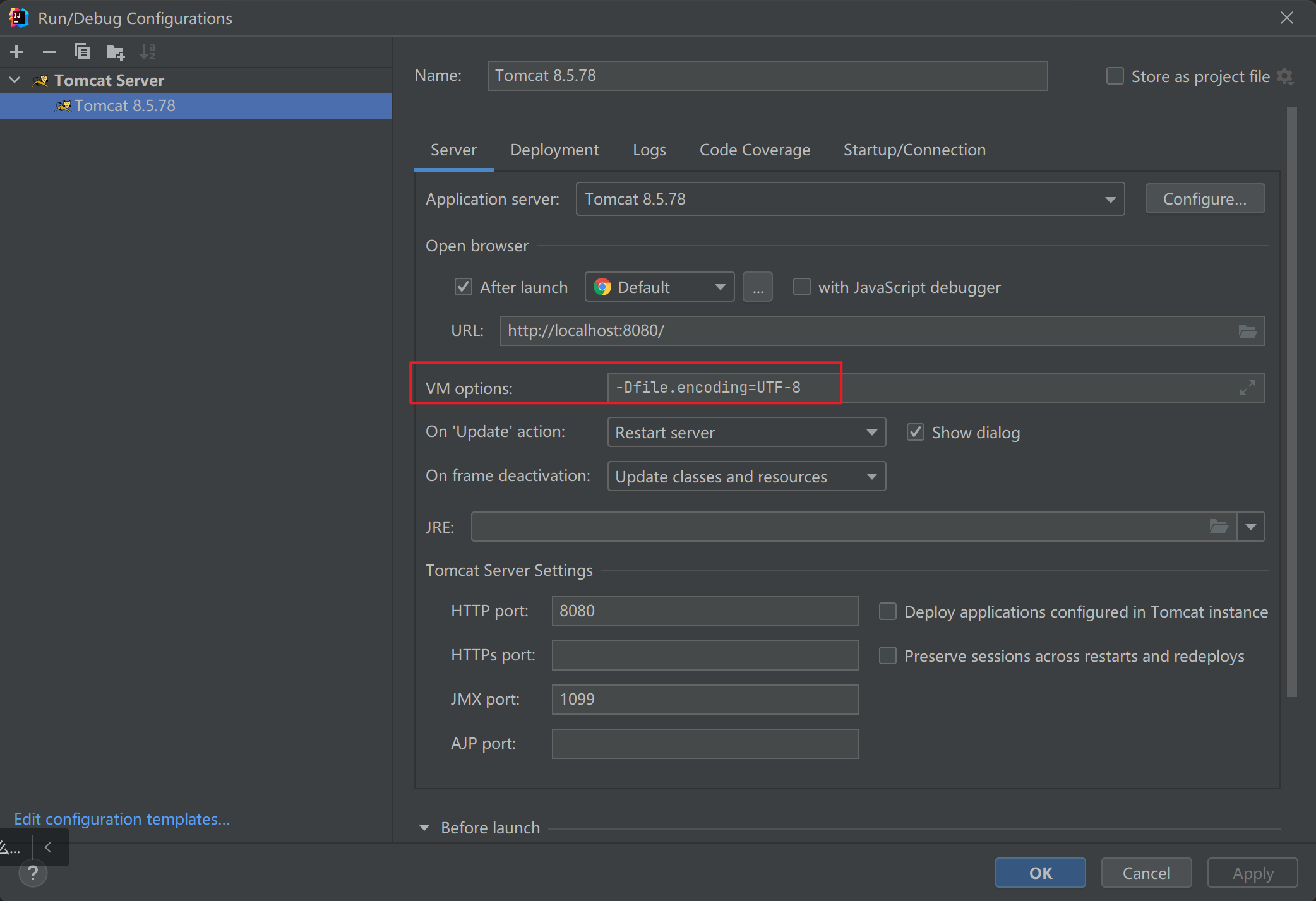
其次,tomcat中字符集设置,对get请求中,中文参数乱码有效
// Tomcat配置:URIEncoding=utf-8 server.xml
<Connector port="8080" protocol="HTTP/1.1"
connectionTimeout="20000"
redirectPort="8443" URIEncoding="utf-8"/>
最后,设置此filter,对post请求中,中文参数乱码有效
<!-- 此过滤器会进行:request.setCharactorEncoding("utf-8"); -->
<filter>
<filter-name>encoding</filter-name>
<filter-class>org.springframework.web.filter.CharacterEncodingFilter</filter-class>
<init-param>
<param-name>encoding</param-name>
<param-value>utf-8</param-value>
</init-param>
</filter>
<filter-mapping>
<filter-name>encoding</filter-name>
<url-pattern>/*</url-pattern>
</filter-mapping>
四、跳转
4.1 转发
@RequestMapping("/forw")
class ForwardController{
@RequestMapping("/test1")
public String testForward(){
System.out.println("test forward1");
// 转发到 /views/users.jsp
return "views/users";
}
@RequestMapping("/test2")
public String testForward2(){
System.out.println("test forward2");
//转发到 /forw/test1
//return "forward:test1"; //相对路径(转发到本类中的test1)接口
return "forward:/forw/test1"; //绝对路径 资源
}
}
提示
总结:
1、如果是转发到JSP页面,直接返回字串就OK
2、如果是转发到其他请求地址,就使用forward
4.2 重定向
@RequestMapping("/redir")
class RedirectController{
@RequestMapping("/test1")
public String testRedirect1(){
System.out.println("test redirect1");
// 重定向到 /redir/test2
// return "redirect:test2"; //相对路径(转发到本类中的test2)
return "redirect:/redir/test2";//绝对路径
}
@RequestMapping("/test2")
public String testRedirect2(){
System.out.println("test redirect2");
//重定向到 /views/users.jsp
return "redirect:/view/user.jsp";
}
}
4.3 跳转细节
提示
在增删改之后,为了防止请求重复提交,重定向跳转
在查询之后,可以做转发跳转
五、传值
提示
前面的在Controller的方法中接收的是页面传递过来的参数 View ==> Controller
那么Controller 的数据怎么传递到 View页面呢?
C得到数据后,跳转到V,并向V传递数据。进而V中可以渲染数据,让用户看到含有数据的页面
转发跳转:Request作用域
重定向跳转:Session作用域
5.1 Request和Session
//形参中 即可获得 request 和 session对象
@RequestMapping("/test1")
public String testData(HttpSession session,HttpServletRequest req,Integer id){
session.setAttribute("user",new User());
req.setAttribute("age", 18);
req.setAttribute("users",Arrays.asList(new User(),new User()));
return "user";
}
5.2 JSP中取值
建议:重点复习 EL JSTL
//jsp中用EL表达式 取值即可
${sessionScope.user.birth} <br>
${requestScope.age}
5.3 Model
//model中的数据,会在V渲染之前,将数据复制一份给request
@RequestMapping("/test")
public String testData(Model model){
model.addAttribute("name", "张三");
return "user"; //视图地址
}
//jsp中用EL表达式 取值即可
${requestScope.name}
5.4 ModelAndView
//modelandview 可以集中管理 跳转和数据
@RequestMapping("/test")
public ModelAndView testData(){//返回值类型为ModelAndView
//新建ModelAndView对象
ModelAndView mv = new ModelAndView();
// 设置视图名,即如何跳转
mv.setViewName("index");
// 增加数据
mv.addObject("age",18);
return mv;
}
//jsp中用EL表达式 取值即可
${requestScope.age}
5.5 @SessionAttributes
@SessionAttributes({"gender","name"}) :model中的 name和gender 会存入session中
SessionStatus 移除session
@Controller
@SessionAttributes({"gender","name"}) // model中的 name和gender 会存入session中
public class UserController {
@RequestMapping("/hello")
public String hello(Model m){
m.addAttribute("gender",true); // 会存入session
m.addAttribute("name","zhj"); // 会存入session
return "index";
}
@RequestMapping("/logout")
public String hello(SessionStatus status){
// 移除通过SessionAttributes存入的session
status.setComplete();
return "index";
}
}
六、静态资源
6.1 静态资源问题
静态:无论谁什么时间访问,内容不变化
动态资源:看到的内容不一致的
静态资源:html,js文件,css文件,图片文件
静态文件没有url-pattern,所以默认是访问不到的,之所以可以访问,是因为,tomcat中有一个全局的servlet:org.apache.catalina.servlets.DefaultServlet,它的url-pattern是 "/",是全局默认的Servlet. 所以每个项目中不能匹配的静态资源的请求,有这个Servlet来处理即可。
但,在SpringMVC中DispatcherServlet也采用了 “/” 作为url-pattern, 则项目中不会再使用全局的Serlvet,则静态资源不能完成访问。
6.2 解决方案1
DispathcerServlet采用其他的url-pattern
此时,所有访问handler的路径都要以 action结尾!!
<servlet>
<servlet-name>mvc9</servlet-name>
<servlet-class>org.springframework.web.servlet.DispatcherServlet</servlet-class>
</servlet>
<servlet-mapping>
<servlet-name>mvc9</servlet-name>
<url-pattern>*.action</url-pattern>
</servlet-mapping>
6.3 解决方案2[推荐]
DispathcerServlet的url-pattern依然采用 "/",但追加配置
<!--
额外的增加一个handler,且其requestMapping: "/**" 可以匹配所有请求,但是优先级最低
所以如果其他所有的handler都匹配不上,请求会转向 "/**" ,恰好,这个handler就是处理静态资源的
处理方式:将请求转会到tomcat中名为default的Servlet
-->
<mvc:default-servlet-handler/>
6.4 解决方案3
- mapping是访问路径,location是静态资源存放的路径
- 将/html/** 中 /**匹配到的内容,拼接到 /hhh/后
http://..../html/a.html 访问 /hhh/a.html
<mvc:resources mapping="/html/**" location="/hhh/"/>
七、Json处理
7.1 导入依赖
<!-- Jackson springMVC默认的Json解决方案选择是 Jackson,所以只需要导入jackson的jar,即可使用。-->
<dependency>
<groupId>com.fasterxml.jackson.core</groupId>
<artifactId>jackson-databind</artifactId>
<version>2.9.8</version>
</dependency>
7.2 使用@ResponseBody
@Controller
public class JsonController{
@RequestMapping("/test1")
@ResponseBody //将handler的返回值,转换成json(jackson),并将json响应给客户端。
public User hello1(){
System.out.println("hello world");
User user = new User();
return user;
}
// @ResponseBody还可以用在handler的返回值上
@RequestMapping("/test2")
public @ResponseBody List<User> hello2(){
System.out.println("hello world");
List<User> users = Arrays.asList(new User(),new User());
return users;
}
// 如果返回值已经是字符串,则不需要转json,直接将字符串响应给客户端
@RequestMapping(value="/test3",produces = "text/html;charset=utf-8") //produces 防止中文乱码
@ResponseBody
public String hello2(){
System.out.println("hello world");
return "你好";
}
}
7.3 使用@RestController
Controller类上加了@RestController注解,等价于在类中的每个方法上都加了@ResponseBody
@RestController
public class JsonController{
@RequestMapping("/test1")
public User hello1(){
System.out.println("hello world");
User user = new User();
return user;
}
//@ResponseBody还可以用在handler的返回值上
@RequestMapping("/test2")
public List<User> hello2(){
System.out.println("hello world");
List<User> users = Arrays.asList(new User(),new User());
return users;
}
}
提示
上午就学习了一个注解 @ResponseBody // 这个注解的作用是,方法的返回值直接放入到响应体中
7.4 使用@RequestBody
@RequestBody, 接收Json参数
7.4.1 定义Handler
class User{
private Integer id;
private String name;
private Boolean gender;
//set get
}
@RequestMapping("/users")
public String addUser(@RequestBody User user){//@RequestBody将请求体中的json数据转换为java对象
System.out.println("cap2");
System.out.println("Post user :"+user);
return "index";
}
7.4.2 Ajax发送json
var xhr = new XMLHttpRequest();
xhr.open("post","${pageContext.request.contextPath}/users?"+new Date().getTime());
xhr.setRequestHeader("content-type","application/json");//设置请求头
xhr.send('{"id":1,"name":"shine","gender":"true"}');//传递json串
//ajax
var user = {id:1,name:"shine"};
$.ajax({
url:'${pageContext.request.contextPath}/json2/test4',
type:'post',
contentType:"application/json",//声明请求参数类型为 json
data:JSON.stringify(user),// 转换js对象成json
success:function(ret){
console.log(ret);
}
});
注意:type类型是post
7.5 Jackson常用注解
7.5.1 日期格式化
@JsonFormat(pattern="yyyy-MM-dd HH:mm:ss",timezone = "GMT+8")
public class User{
private Integer id;
private String name;
@JsonFormat(pattern="yyyy-MM-dd",timezone = "GMT+8")
private Date birth;
....
get/set
}
7.5.2 属性名修改
@JsonProperty("new_name")
指定json序列化的别名@JsonProperty
public class User{
@JsonProperty("new_id") //不再使用原属性名,而是 "new_id"
private Integer id;
private String name;
....
get/set
}
输出的json:{“new_id”:xx,"name":"xx"}
7.5.3 属性忽略
@JsonIgnore
public class User{
private Integer id;
@JsonIgnore // 生成json时,忽略此属性
private String name;
....
get/set
}
输出json时: {"id":xx}
7.5.4 null和empty属性排除
Jackson 默认会输出null值的属性,如果不需要,可以排除。
@JsonInclude(JsonInclude.Include.NON_NULL) //null值 属性不输出
@JsonInclude(value= JsonInclude.Include.NON_EMPTY) // empty属性不输出( 空串,长度为0的集合,null值)
public class User{
private Integer id;
@JsonInclude(JsonInclude.Include.NON_NULL) // 若"name==null" 忽略此属性
private String name;
@JsonInclude(value= JsonInclude.Include.NON_EMPTY) // 若hobby长度为0或==null 忽略此属性
private List<String> hobby;
....
get/set
}
如果name=null,且 hobby长度为0,则输出json时:{"id":xx}
ElementType.TYPE 表示注解可以标注在类上
ElementType.METHOD 表示注解可以标注在方法上
ElementType.FIELD 表示注解可以标注在属性上
ElementType.PARAMETER 表示注解可以标注在参数上
7.5.5 自定义序列化
@JsonSerialize(using = MySerializer.class) // 使用MySerializer输出某属性
public class User {
private Integer id;
private String name;
@JsonSerialize(using = MySerializer.class)
private Double salary = 10000.126;//在输出此属性时,使用MySerializer输出
....
get/set
}
则输出json时:{"id":xx,"name":"xxx","salary":10000.13}
public class MySerializer extends JsonSerializer<Double> {
// value即 Double salary的值
@Override
public void serialize(Double value, JsonGenerator gen, SerializerProvider serializers) throws IOException {
// 将Double salary的值 四舍五入
String number = BigDecimal.valueOf(value).setScale(2, BigDecimal.ROUND_HALF_UP).toString();
// 输出 四舍五入后的值
gen.writeNumber(number);
}
}
7.6 FastJson
阿里巴巴fastjson 和 jackson 任选其一;
7.6.1 导入依赖
<!-- FastJson -->
<dependency>
<groupId>com.alibaba</groupId>
<artifactId>fastjson</artifactId>
<version>1.2.54</version>
</dependency>
7.6.2 安装FastJson
<!--MVC注解驱动-->
<mvc:annotation-driven>
<!--指定配置多个自定义的消息转换器-->
<mvc:message-converters>
<!-- 需要在这里指定使用阿里巴巴的fastjson的消息转换器 -->
<bean class="com.alibaba.fastjson.support.spring.FastJsonHttpMessageConverter">
<!--supportedMediaTypes:这个消息转换器可以处理哪种类型的数据-->
<property name="supportedMediaTypes">
<list>
<value>application/json</value>
</list>
</property>
<!--指定序列化的特征值,跟注解的作用是一样的-->
<property name="features">
<list>
<!--使用默认的日期格式序列化日期-->
<value>WriteDateUseDateFormat</value>
</list>
</property>
</bean>
</mvc:message-converters>
</mvc:annotation-driven>
7.6.3 使用
@ResponseBody @RequestBody @RestController 使用方法不变
7.6.4 常用注解
- 日期格式化:@JSONField(format="yyyy/MM/dd")
- 属性名修改:@JSONField(name="birth")
- 忽略属性:@JSONField(serialize = false)
- 包含null值:@JSONField(serialzeFeatures = SerializerFeature.WriteMapNullValue) 默认会忽略所有null值,有此注解会输出null
- @JSONField(serialzeFeatures = SerializerFeature.WriteNullStringAsEmpty) null的String输出为""
- 自定义序列化:@JSONField(serializeUsing = MySerializer2.class)
@Data
public class FastUser {
// WriteMapNullValue 序列化null值的属性 ,WriteNullStringAsEmpty 遇到null -> ""
@JSONField(serialzeFeatures = {SerializerFeature.WriteMapNullValue, SerializerFeature.WriteNullStringAsEmpty})
private String id;
@JSONField(name = "name")
private String username;
// serialize = false 序列化时忽略这个属性
@JSONField(serialize = false)
private String password;
// format 指定日期格式的
// @JSONField(format = "yyyy年MM月dd日")
private Date birthday;
@JSONField(format = "yyyy年MM月dd日")
private Date marryDay;
private Double salary;
}
public class MySerializer2 implements ObjectSerializer {
@Override
public void write(JSONSerializer serializer, Object object, Object fieldName, Type fieldType,
int features) throws IOException {
Double value = (Double) object; // salary属性值
String text = value + "元";// 在salary后拼接 “元”
serializer.write(text); // 输出拼接后的内容
}
}
new User(1,null,null,new Date(),100.5);
// 如上对象,转换json:
{NAME:"",city:null,"birth":"2020/12/12","salary":"100.5元"}
八、异常解析器
8.1 现有方案,分散处理
Controller中的每个Handler自己处理异常
此种处理方案,异常处理逻辑,分散在各个handler中,不利于集中管理
public String xxx(){
try{
...
}catch(Exception1 e){
e.printStackTrace();
return "redirect:/xx/error1";
}catch(Exception2 e){
e.printStackTrace();
return "redirect:/xx/error2";
}
}
8.2 异常解析器,统一处理
Controller中的每个Handler不再自己处理异常,而是直接throws所有异常。
定义一个“异常解析器” 集中捕获处理 所有异常
此种方案,在集中管理异常方面,更有优势!
8.3 自定义异常
package com.glls.exception;
import java.io.Serializable;
public class CustomerException extends Exception implements Serializable {
private static final long serialVersionUID = -5212079010855161498L;
public CustomerException() {
}
public CustomerException(String message) {
super(message);
}
}
8.4 自定义异常解析器
package com.glls.exception;
import org.springframework.web.servlet.HandlerExceptionResolver;
import org.springframework.web.servlet.ModelAndView;
import javax.servlet.http.HttpServletRequest;
import javax.servlet.http.HttpServletResponse;
public class CustomExceptionResolver implements HandlerExceptionResolver {
/**
* 异常解析器:主体逻辑
* 执行时刻:当handler中抛出异常时,会执行:捕获异常,并可以跳到错误页面
*/
@Override
public ModelAndView resolveException(HttpServletRequest httpServletRequest, HttpServletResponse httpServletResponse, Object o, Exception e) {
CustomerException customerException = null;
if(e instanceof CustomerException){
customerException = (CustomerException) e;
}else{
// 如果系统抛出的异常 不是自定义异常 可以重新构造一个未知错误异常
customerException = new CustomerException("未知错误,请联系系统管理员");
}
ModelAndView modelAndView = new ModelAndView();
modelAndView.addObject("error",customerException.getMessage());
modelAndView.setViewName("error");
return modelAndView;
}
}
<!-- 声明异常解析器 -->
<bean id="handlerExceptionResolver" class="com.glls.exception.CustomExceptionResolver"/>
九、拦截器
Filter: 类似于过滤器的作用,在请求进入处理器之前,之后执行
9.1 作用
作用:抽取handler中的冗余功能
9.2 定义拦截器
执行顺序: preHandle--postHandle--afterCompletion
package com.qf.springmvc02.interceptor;
import com.qf.springmvc02.entity.User;
import org.springframework.web.servlet.HandlerInterceptor;
import org.springframework.web.servlet.ModelAndView;
import javax.servlet.http.HttpServletRequest;
import javax.servlet.http.HttpServletResponse;
import javax.servlet.http.HttpSession;
import java.util.Objects;
/**
* @author zed
* @date 2022/5/5 11:04
* 自定义拦截器
*/
public class MyInterceptor implements HandlerInterceptor {
// preHandle是在处理器Handler执行之前执行的 返回true就是让请求继续执行,false:后续拦截器和处理器不执行了直接返回
@Override
public boolean preHandle(HttpServletRequest request, HttpServletResponse response, Object handler) throws Exception {
// System.out.println("preHandle 执行...");
// 登录权限验证的拦截
// 从session中取出来登录的用户,判断用户是否登录过,然后决定是进行拦截或者放行
HttpSession session = request.getSession();
User user = (User) session.getAttribute("user");
if(Objects.isNull(user)){
// 说明没有登录,拦截,返回到登录页面
request.setAttribute("error","用户名或密码错误");
request.getRequestDispatcher("/index.jsp").forward(request,response);
}
// 如果登录过,就放行
return true;
}
}
9.3 配置拦截路径
<!--配置拦截器-->
<mvc:interceptors>
<mvc:interceptor>
<!--所有路径都要拦截-->
<mvc:mapping path="/**"/>
<!--不拦截哪些路径-->
<mvc:exclude-mapping path="/login"/>
<mvc:exclude-mapping path="/upload"/>
<mvc:exclude-mapping path="/css/**"/>
<mvc:exclude-mapping path="/js/**"/>
<!--指定拦截器类-->
<bean class="com.qf.springmvc02.interceptor.MyInterceptor" />
</mvc:interceptor>
</mvc:interceptors>
注意:不要拦截静态文件路径!!!
十、上传与下载
文件上传是项目开发中最常见的功能之一 ,springMVC 可以很好的支持文件上传,但是SpringMVC上下文中默认没有装配MultipartResolver,因此默认情况下其不能处理文件上传工作。如果想使用Spring的文件上传功能,则需要在上下文中配置MultipartResolver。
10.1 文件上传三要素
- 表单的提交方式 method="POST"
- 表单的enctype属性是多部分表单形式 enctype=“multipart/form-data"
- 表单项(元素)type="file"
<%@ page contentType="text/html;charset=UTF-8" pageEncoding="UTF-8" %>
<html>
<head>
<title>文件上传</title>
</head>
<body>
${requestScope.msg}
<form action="${pageContext.request.contextPath}/upload" enctype="multipart/form-data" method="post">
名字:<input type="text" name="name"><br />
文件:<input type="file" name="upload"><br />
<input type="submit" value="提交">
</form>
</body>
</html>
10.2 enctype 属性值
application/x-www-form-urlencoded
默认方式,只处理表单域中的 value 属性值,采用这种编码方式的表单会将表单域中的值处理成 URL 编码方式。
multipart/form-data
这种编码方式会以二进制流的方式来处理表单数据,这种编码方式会把文件域指定文件的内容也封装到请求参数中,不会对字符编码。
text/plain
除了把空格转换为 "+" 号外,其他字符都不做编码处理,这种方式适用直接通过表单发送邮件。
注意:
一旦设置了enctype为multipart/form-data,浏览器即会采用二进制流的方式来处理表单数据,而对于文件上传的处理则涉及在服务器端解析原始的HTTP响应。
10.3文件上传的方式
使用apache提供的工具类 commons-fileupload(麻烦)
使用servlet3.0版本,通过注解使用
使用SpirngMVC的MultipartResolver
Spring MVC使用Apache Commons FileUpload技术实现了一个MultipartResolver实现类,
因此,SpringMVC的文件上传还需要依赖Apache Commons FileUpload的组件。
10.4 文件上传操作步骤
10.4.1 导入依赖
<!--文件上传-->
<dependency>
<groupId>commons-fileupload</groupId>
<artifactId>commons-fileupload</artifactId>
<version>1.4</version>
</dependency>
<!--servlet 需要这个依赖 并且 tomcat8 版本 要不会有 request 转换异常-->
<dependency>
<groupId>javax.servlet</groupId>
<artifactId>javax.servlet-api</artifactId>
<version>4.0.1</version>
<scope>provided</scope>
</dependency>
10.4.2 编写表单
<%@ page contentType="text/html;charset=UTF-8" pageEncoding="UTF-8" %>
<html>
<head>
<title>文件上传</title>
</head>
<body>
${requestScope.msg}
<form action="${pageContext.request.contextPath}/upload" enctype="multipart/form-data" method="post">
名字:<input type="text" name="name"><br />
文件:<input type="file" name="upload"><br />
<input type="submit" value="提交">
</form>
</body>
</html>
10.4.3 配置文件上传组件
<!--配置文件上传的解析器 id必须是multipartResolver !!!!-->
<bean id="multipartResolver" class="org.springframework.web.multipart.commons.CommonsMultipartResolver">
<!--maxUploadSize 允许用户上传文件的大小-->
<property name="maxUploadSize" value="10485760" />
<!--上传文件编码类型-->
<property name="defaultEncoding" value="UTF-8" />
</bean>
10.4.4 编写UploadAndDownloadController
package com.qf.springmvc02.controller;
import org.springframework.stereotype.Controller;
import org.springframework.ui.Model;
import org.springframework.web.bind.annotation.RequestMapping;
import org.springframework.web.multipart.MultipartFile;
import javax.servlet.http.HttpServletRequest;
import java.io.File;
import java.io.IOException;
/**
* @author zed
* @date 2022/5/5 14:13
*/
@Controller
public class FileController {
@RequestMapping("/upload")
public String upload(MultipartFile upload, String name, Model model, HttpServletRequest request) throws IOException {
// name用户名字,upload上传的文件
// 1、获取web服务器中部署项目在磁盘上的真实路径
String realPath = request.getServletContext().getRealPath("/");
System.out.println(realPath);
// 2、在上述路径下创建一个upload文件夹
File uploadDir = new File(realPath, "upload");
if (!uploadDir.exists()) {
// 如果upload目录不存在就创建一个目录
uploadDir.mkdirs();
}
// 3、获取上传文件的名字
String filename = upload.getOriginalFilename();
// 3.1 如果只允许用户上传图片,不能上传其他文件 xxx.jpg xxx.png xxx.bmp xxx.gif
// 获取文件后缀名
String suffix = filename.substring(filename.indexOf("."));
if (suffix.equalsIgnoreCase(".jpg") || suffix.equalsIgnoreCase(".png")
|| suffix.equalsIgnoreCase(".bmp") || suffix.equalsIgnoreCase(".gif")) {
// 3.2 重命名文件
String uuid = UUID.randomUUID().toString();
uuid = uuid.replace("-", "") + suffix;
// 4、IO流操作进行文件复制
upload.transferTo(new File(uploadDir, uuid));
model.addAttribute("msg", "文件上传成功!");
// 5、在页面上显示一下上传文件目录中都有哪些文件
String[] fileNames = uploadDir.list();
model.addAttribute("fileNames", fileNames);
return "welcome";
} else {
// 上传的不是图片
model.addAttribute("msg", "上传的不是图片!");
return "upload";
}
}
}
result.jsp
<%@ page contentType="text/html;charset=UTF-8" pageEncoding="UTF-8" %>
<%@ taglib prefix="c" uri="http://java.sun.com/jsp/jstl/core" %>
<html>
<head>
<title>欢迎页面</title>
</head>
<body>
<h1>登录成功,欢迎您 ${sessionScope.user.username}</h1>
<h1>${requestScope.msg}</h1>
<hr />
<c:forEach items="${requestScope.fileNames}" var="file">
<a href="${pageContext.request.contextPath}/upload/${file}">${file}</a><br/>
</c:forEach>
</body>
</html>
10.4.5 多文件上传
<form action="${pageContext.request.contextPath}/method2" method="post" enctype="multipart/form-data" >
用户名: <input type="text" name="name"> <br>
文件: <input type="file" name="upload">
文件: <input type="file" name="upload">
文件: <input type="file" name="upload">
<br>
<input type="submit" value="提交">
</form>
------------------------------------------------------------------
@RequestMapping("/method2")
public String upload2(MultipartFile[] upload,String name, HttpServletRequest request) throws IOException {
System.out.println(name);
System.out.println(upload);
for(MultipartFile multipartFile:upload){
String filename = multipartFile.getOriginalFilename();
String suffix = filename.substring(filename.lastIndexOf("."));
if(suffix.equalsIgnoreCase(".jpg")){
String uuid = UUID.randomUUID().toString();
multipartFile.transferTo(new File("E://",uuid + suffix));
request.setAttribute("result","上传成功");
}else{
request.setAttribute("result","上传失败");
}
}
return "result";
}
10.5 文件下载
// 文件下载的处理器
@RequestMapping("/download")
public void download(String filename, HttpServletResponse response,HttpServletRequest request) throws IOException {
System.out.println("要下载的文件名是:"+filename);
// 设置响应的格式 执行让浏览器使用附件attachment的形式下载文件
response.setHeader("content-disposition","attachment;filename="+filename);
// 获取下载的文件所在目录的真实地址
String realPath = request.getServletContext().getRealPath("/upload");
// 获取你要下载的文件对象,构造要下载的文件对象
File file = new File(realPath, filename);
// 读取文件内容到字节数组中
byte[] bytes = FileUtils.readFileToByteArray(file);
ServletOutputStream outputStream = response.getOutputStream();
// 把字节数组写入到输出流中
outputStream.write(bytes);
outputStream.close();
}
十一、验证码
11.1 作用
防止暴力攻击,前端安全保障
11.2 导入jar
<!-- Kaptcha -->
<dependency>
<groupId>com.github.penggle</groupId>
<artifactId>kaptcha</artifactId>
<version>2.3.2</version>
<exclusions>
<exclusion>
<groupId>javax.servlet</groupId>
<artifactId>javax.servlet-api</artifactId>
</exclusion>
</exclusions>
</dependency>
11.3 声明验证码组件
<servlet>
<servlet-name>cap</servlet-name>
<servlet-class>com.google.code.kaptcha.servlet.KaptchaServlet</servlet-class>
<init-param>
<param-name>kaptcha.border</param-name>
<param-value>no</param-value>
</init-param>
<init-param>
<param-name>kaptcha.textproducer.char.length</param-name>
<param-value>4</param-value>
</init-param>
<init-param>
<param-name>kaptcha.textproducer.char.string</param-name>
<param-value>abcdefghijklmnopqrstuvwxyzABCDEFGHIJKLMNOPQRSTUVWXYZ0123456789</param-value>
</init-param>
<init-param>
<param-name>kaptcha.background.clear.to</param-name>
<param-value>211,229,237</param-value>
</init-param>
<init-param>
<!-- session.setAttribute("captcha","验证码") -->
<param-name>kaptcha.session.key</param-name>
<param-value>captcha</param-value>
</init-param>
</servlet>
<servlet-mapping>
<servlet-name>cap</servlet-name>
<url-pattern>/captcha</url-pattern>
</servlet-mapping>
11.4 Page
<img src="${pageContext.request.contextPath}/captcha" style="width:85px" id="cap"/>
<script>
$(function(){
$("#cap").click(function(){
//刷新验证码
path = $(this).attr("src")+"?"+new Date().getTime();
$(this).attr("src",path);
});
});
</script>
十二、REST
12.1 开发风格
是一种开发风格,遵从此风格开发软件,符合REST风格,则RESTFUL。
两个核心要求:
- 每个资源都有唯一的标识(URL)
- 不同的行为,使用对应的http-method
| 访问标识 | 资源 |
|---|---|
| http://localhost:8989/xxx/users | 所有用户 |
| http://localhost:8989/xxx/users/1 | 用户1 |
| http://localhost:8989/xxx/users/1/orders | 用户1的所有订单 |
| 请求方式 | 标识 | 意图 |
|---|---|---|
| GET | http://localhost:8989/xxx/users | 查询所有用户 |
| POST | http://localhost:8989/xxx/users | 在所有用户中增加一个 |
| PUT | http://localhost:8989/xxx/users | 在所有用户中修改一个 |
| DELETE | http://localhost:8989/xxx/users/1 | 删除用户1 |
| GET | http://localhost:8989/xxx/users/1 | 查询用户1 |
| GET | http://localhost:8989/xxx/users/1/orders | 查询用户1的所有订单 |
| POST | http://localhost:8989/xxx/users/1/orders | 在用户1的所有订单中增加一个 |
12.2 优点
- 职责清晰:url表示资源 type表示对资源的操作方式
12.3 使用
12.3.1 定义Rest风格的 Controller
@RequestMapping(value="/users",method = RequestMethod.GET)
等价
@GetMapping("/users")
@RestController
public class RestController {
@GetMapping("/users")
public List<User> queryAllUsers(){
System.out.println("get");
List<User> users = ....
return users;
}
@PostMapping("/users")
public String addUser(@RequestBody User user){
System.out.println("Post user :"+user);
return "{status:1}";
}
@PutMapping("/users")
public String updateUser(@RequestBody User user){
System.out.println("Put user" user:"+user);
return "{status:1}";
}
@GetMapping("/users/{id}")
public String queryOneUser(@PathVariable Integer id){//@PathVariable 接收路径中的值
System.out.println("Get user id:"+id);
return "{status:1}";
}
@DeleteMapping("/users/{id}")
public String deleteOneUser(@PathVariable Integer id){//@PathVariable 接收路径中的值
System.out.println("delete user id:"+id);
return "{status:1}";
}
}
12.3.2 Ajax请求
<script>
// 。。。 省略其他代码
// 发送更新请求 (增加请求发送方式也是如此)
$.ajax({
url:'${pageContext.request.contextPath}/rest04/users',
type:'put',
contentType:"application/json",//声明请求参数类型为 json
data:JSON.stringify(user),// 转换js对象成json
success:function(ret){
console.log(JSON.parse(ret));
}
});
</script>
十三、跨域请求
13.1 域
域:协议+IP+端口
13.2 Ajax跨域问题
Ajax发送请求时,不允许跨域,以防用户信息泄露。
当Ajax跨域请求时,响应会被浏览器拦截(同源策略),并报错。即浏览器默认不允许ajax跨域得到响应内容。
互相信任的域之间如果需要ajax访问,(比如前后端分离项目中,前端项目和后端项目之间),则需要额外的设置才可正常请求。
13.3 解决方案
允许其他域访问
在被访问方的Controller类上,添加注解
@CrossOrigin("http://localhost:8080") //允许此域发请求访问
public class SysUserController {
....
}
携带对方cookie,使得session可用
在访问方,ajax中添加属性:withCredentials: true
$.ajax({
type: "POST",
url: "http://localhost:8989/web/sys/login",
...,
xhrFields: {
// 跨域携带cookie
withCredentials: true
}
});
或
var xhr = new XMLHttpRequest();
// 跨域携带cookie
xhr.withCredentials=true;
十四、SpringMVC执行流程
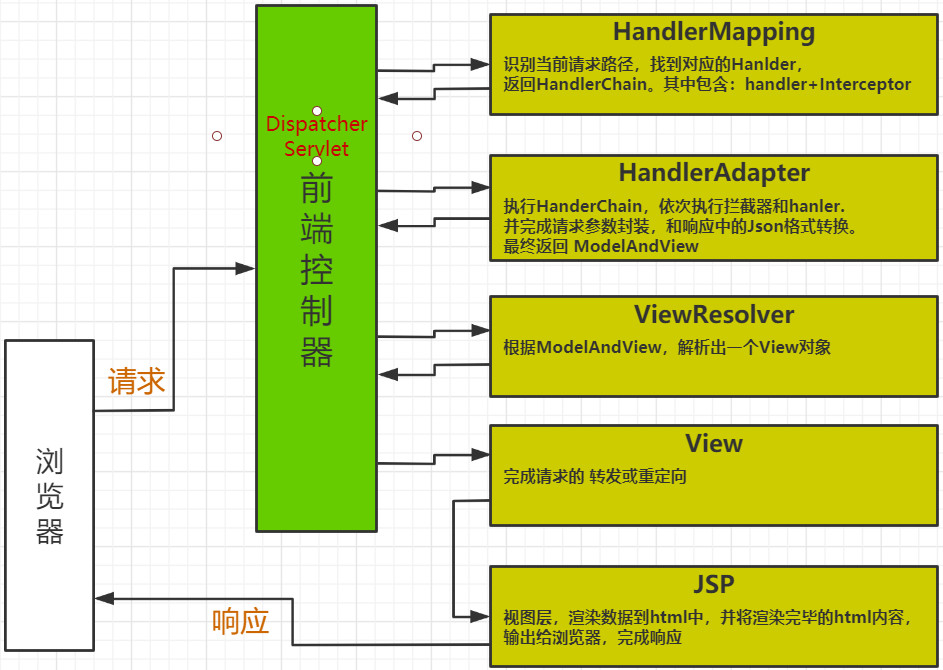 |
十五、Spring整合
15.1 整合思路
此时项目中有两个工厂
- DispatcherServlet 启动的springMVC工厂==负责生产C及springMVC自己的系统组件
- ContextLoaderListener 启动的spring工厂==负责生产其他所有组件
- springMVC的工厂会被设置为spring工厂的子工厂,可以随意获取spring工厂中的组件
- 整合过程,就是累加:代码+依赖+配置。然后将service注入给controller即可
15.2 整合技巧
两个工厂不能有彼此侵入,即,生产的组件不能有重合。
<!-- 告知SpringMVC 哪些包中 存在 被注解的类
use-default-filters=true 凡是被 @Controller @Service @Repository注解的类,都会被扫描
use-default-filters=false 默认不扫描包内的任何类, 只扫描include-filter中指定的类
只扫描被@Controller注解的类
-->
<context:component-scan base-package="com.zhj" use-default-filters="false">
<context:include-filter type="annotation" expression="org.springframework.stereotype.Controller"/>
</context:component-scan>
<!-- 告知Spring
唯独不扫描@Controller注解的类 -->
<context:component-scan base-package="com.zhj" use-default-filters="true">
<context:exclude-filter type="annotation" expression="org.springframework.stereotype.Controller"/>
</context:component-scan>
15.3 ssm 整合
1.准备 数据库 ssm 准备表
2.创建 maven 的 web 工程 ssm
3.添加依赖
<?xml version="1.0" encoding="UTF-8"?>
<project xmlns="http://maven.apache.org/POM/4.0.0" xmlns:xsi="http://www.w3.org/2001/XMLSchema-instance"
xsi:schemaLocation="http://maven.apache.org/POM/4.0.0 http://maven.apache.org/xsd/maven-4.0.0.xsd">
<modelVersion>4.0.0</modelVersion>
<groupId>com.glls</groupId>
<artifactId>ssm</artifactId>
<version>1.0-SNAPSHOT</version>
<packaging>war</packaging>
<name>ssm Maven Webapp</name>
<!-- FIXME change it to the project's website -->
<url>http://www.example.com</url>
<properties>
<project.build.sourceEncoding>UTF-8</project.build.sourceEncoding>
<maven.compiler.source>1.8</maven.compiler.source>
<maven.compiler.target>1.8</maven.compiler.target>
</properties>
<dependencies>
<dependency>
<groupId>junit</groupId>
<artifactId>junit</artifactId>
<version>4.12</version>
<scope>test</scope>
</dependency>
<!-- https://mvnrepository.com/artifact/org.springframework/spring-test -->
<dependency>
<groupId>org.springframework</groupId>
<artifactId>spring-test</artifactId>
<version>5.2.0.RELEASE</version>
<scope>test</scope>
</dependency>
<dependency>
<groupId>mysql</groupId>
<artifactId>mysql-connector-java</artifactId>
<version>8.0.15</version>
</dependency>
<dependency>
<groupId>org.mybatis</groupId>
<artifactId>mybatis</artifactId>
<version>3.4.6</version>
</dependency>
<!-- https://mvnrepository.com/artifact/com.alibaba/druid -->
<dependency>
<groupId>com.alibaba</groupId>
<artifactId>druid</artifactId>
<version>1.1.10</version>
</dependency>
<!-- https://mvnrepository.com/artifact/commons-logging/commons-logging -->
<dependency>
<groupId>commons-logging</groupId>
<artifactId>commons-logging</artifactId>
<version>1.2</version>
</dependency>
<!-- https://mvnrepository.com/artifact/org.slf4j/slf4j-log4j12 -->
<!--日志-->
<dependency>
<groupId>org.slf4j</groupId>
<artifactId>slf4j-log4j12</artifactId>
<version>1.7.25</version>
</dependency>
<!-- https://mvnrepository.com/artifact/org.apache.logging.log4j/log4j-core -->
<!--日志-->
<dependency>
<groupId>org.apache.logging.log4j</groupId>
<artifactId>log4j-core</artifactId>
<version>2.11.2</version>
<exclusions>
<exclusion>
<artifactId>log4j-api</artifactId>
<groupId>org.apache.logging.log4j</groupId>
</exclusion>
</exclusions>
</dependency>
<!--spring-->
<!-- https://mvnrepository.com/artifact/org.springframework/spring-aspects -->
<dependency>
<groupId>org.springframework</groupId>
<artifactId>spring-aspects</artifactId>
<version>5.2.0.RELEASE</version>
</dependency>
<!-- https://mvnrepository.com/artifact/org.springframework/spring-context -->
<dependency>
<groupId>org.springframework</groupId>
<artifactId>spring-context</artifactId>
<version>5.2.0.RELEASE</version>
</dependency>
<!-- https://mvnrepository.com/artifact/org.mybatis/mybatis-spring -->
<dependency>
<groupId>org.mybatis</groupId>
<artifactId>mybatis-spring</artifactId>
<version>1.3.2</version>
</dependency>
<!-- https://mvnrepository.com/artifact/org.springframework/spring-jdbc -->
<dependency>
<groupId>org.springframework</groupId>
<artifactId>spring-jdbc</artifactId>
<version>5.2.0.RELEASE</version>
</dependency>
<!-- https://mvnrepository.com/artifact/org.springframework/spring-web -->
<dependency>
<groupId>org.springframework</groupId>
<artifactId>spring-web</artifactId>
<version>5.2.0.RELEASE</version>
</dependency>
<!-- https://mvnrepository.com/artifact/javax.servlet/javax.servlet-api -->
<dependency>
<groupId>javax.servlet</groupId>
<artifactId>javax.servlet-api</artifactId>
<version>4.0.1</version>
<scope>provided</scope>
</dependency>
<!-- https://mvnrepository.com/artifact/javax.servlet.jsp/jsp-api -->
<dependency>
<groupId>javax.servlet.jsp</groupId>
<artifactId>jsp-api</artifactId>
<version>2.2</version>
<scope>provided</scope>
</dependency>
<!-- https://mvnrepository.com/artifact/javax.servlet/jstl -->
<dependency>
<groupId>javax.servlet</groupId>
<artifactId>jstl</artifactId>
<version>1.2</version>
</dependency>
<!-- https://mvnrepository.com/artifact/org.springframework/spring-webmvc -->
<dependency>
<groupId>org.springframework</groupId>
<artifactId>spring-webmvc</artifactId>
<version>5.2.0.RELEASE</version>
</dependency>
<!-- https://mvnrepository.com/artifact/com.fasterxml.jackson.core/jackson-databind -->
<dependency>
<groupId>com.fasterxml.jackson.core</groupId>
<artifactId>jackson-databind</artifactId>
<version>2.10.0</version>
</dependency>
<!--文件上传-->
<dependency>
<groupId>commons-fileupload</groupId>
<artifactId>commons-fileupload</artifactId>
<version>1.4</version>
</dependency>
</dependencies>
<build>
<finalName>ssm</finalName>
<resources>
<!--在pom.xml文件中加上配置,让编译器把src/main/java目录下的xml文件一同编译到classes文件夹下-->
<resource>
<directory>src/main/java</directory>
<includes>
<include>**/*.xml</include>
</includes>
</resource>
<resource>
<directory>src/main/resources</directory>
<includes>
<include>**/*.xml</include>
<include>**/*.properties</include>
</includes>
</resource>
</resources>
</build>
</project>
4.web.xml 配置文件
<?xml version="1.0" encoding="UTF-8"?>
<web-app xmlns="http://xmlns.jcp.org/xml/ns/javaee"
xmlns:xsi="http://www.w3.org/2001/XMLSchema-instance"
xsi:schemaLocation="http://xmlns.jcp.org/xml/ns/javaee http://xmlns.jcp.org/xml/ns/javaee/web-app_4_0.xsd"
version="4.0">
<!-- 上下文参数 -->
<context-param>
<param-name>contextConfigLocation</param-name>
<!-- spring 配置文件 -->
<param-value>classpath:beans.xml</param-value>
</context-param>
<!-- 封装了一个监听器,帮助加载 Spring 的配置文件 -->
<listener>
<listener-class>org.springframework.web.context.ContextLoaderListener</listener-class>
</listener>
<!--配置springmvc的前端控制器-->
<servlet>
<servlet-name>springmvc</servlet-name>
<servlet-class>org.springframework.web.servlet.DispatcherServlet</servlet-class>
<init-param>
<param-name>contextConfigLocation</param-name>
<param-value>classpath:mvc.xml</param-value>
</init-param>
<load-on-startup>1</load-on-startup>
</servlet>
<servlet-mapping>
<servlet-name>springmvc</servlet-name>
<!--不要设置为 /* -->
<url-pattern>/</url-pattern>
</servlet-mapping>
<filter>
<filter-name>encodingFilter</filter-name>
<filter-class>org.springframework.web.filter.CharacterEncodingFilter</filter-class>
<init-param>
<param-name>encoding</param-name>
<param-value>utf-8</param-value>
</init-param>
</filter>
<filter-mapping>
<filter-name>encodingFilter</filter-name>
<url-pattern>/*</url-pattern>
</filter-mapping>
</web-app>

